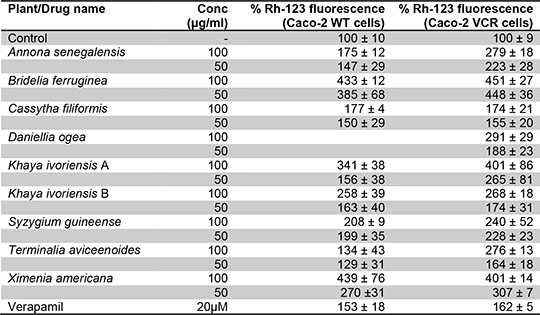Print version
Search Pub Med
The Risk Of Herb-Drug Interactions With Anti-diabetic Plants Used In Nigeria- Modulation of P-glycoprotein Activity And Glutathione Levels Background: Since the emergence of interactions between St. John’s wort (Hypericum perforatum) and a number of conventional medicines, there has been an upsurge in the identification of potential herb-drug interactions for a number of herbal medicinal products (Barnes et al. 2011). Unfortunately, there is little or no information about such interactions for herbal products used in Nigeria despite the fact that a large percentage of the population depend on herbal medicines alongside their prescription drugs for disease management, especially for chronic diseases. Aim: To address this dearth of information, extracts of thirty medicinal plants used traditionally for the management of diabetes in Nigeria were collected during a field work study for in-vitro pharmacokinetic investigations to identify potential herb-drug interactions. Methods: The ability of these plants to modulate the effect of the intestinal efflux transporter P-glycoprotein (P-gp) was determined in wild type Caco-2 cells (Caco-2 WT) and a vincristine resistant Caco-2 cell line having increased P-gp expression (Caco-2 VCR), using the fluorescent P-gp substrate rhodamine-123 (Lee et al. 1994). The effect of the plant extracts on intracellular glutathione (GSH) levels was also determined in HepG2 cells using an enzymatic assay (Allen et al. 2001). 20μM Verapamil and 10mM Acetaminophen were used as positive references for the two assays respectively. Results: All extracts were tested at non-toxic concentrations (≤ 100μg/ml) based on the neutral red cytotoxicity assay. Significant inhibition of P-gp mediated rhodamine-123 efflux was observed for eight of the extracts (Table 1). In addition, three of the extracts produced significantly (P<0.05) lower cellular GSH levels after incubation in the cell (Table 2). Statistical analysis was carried out using ANOVA followed by Bonferroni’s post test.. Conclusion: These preliminary results suggest the potential of herb-drug interactions for herbal remedies containing any of these plant extracts. In particular, extracts of K. ivoriensis and X. americana may pose a serious safety risk when co-administered with prescription drugs as they are interacting with two key mechanisms involved in drug absorption and elimination. 
Table 1: Modulation of P-gp mediated efflux of Rh-123 by plant extracts in wild type and vincristine resistant Caco-2 cells (P < 0.001, n=3). 
Table 2: Cellular GSH levels in HepG2 cells after incubation with plant extracts (P < 0.05, n=3)
References: Barnes J, Anderson LA, Phillipson JD (2011). Herbal Medicines (Online via MedicinesComplete) Lee JS, Paull K, Alvarez M, Hose C, Monks A, Grever M, Fojo AT, Bates SE (1994). Molecular Pharmacology 46: 627-638 Allen S, Shea JM, Felmet T, Gadra J, Dehn PF (2001). Methods in Cell Science 22:305-312
|



